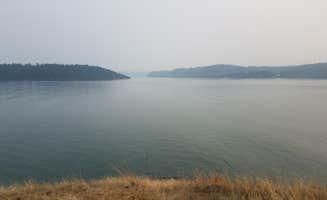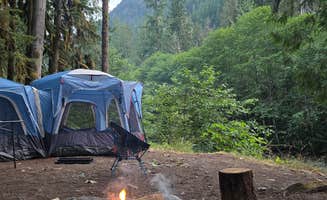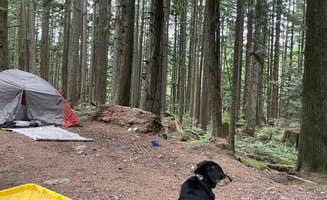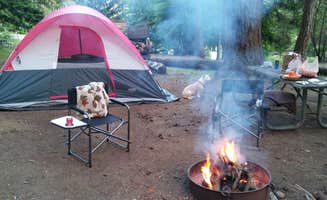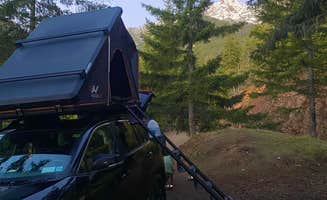Dispersed camping sites near Lynnwood, Washington offer primitive outdoor experiences within a 90-minute drive radius. The region's heavily forested terrain ranges from sea level coastal areas to alpine zones reaching 5,000+ feet elevation. Several National Forest roads provide access to rustic camping opportunities where campers can establish temporary sites along creeks, rivers, and mountain viewpoints.
What to do
Kayak to island campsites: Hope Island Marine State Park is accessible only by watercraft, requiring a short paddle from mainland launch points. "This is an awesome little island! 1 vault toilet, picnic table and fire rings. There were raccoons on the island with us but other than that we had the place to ourselves," reports Jess G., who recommends checking "waters, tide and wind report the day of."
Hike to alpine lakes: Lake Dorothy offers backcountry camping with minimal facilities. "Easy stair stopped trail; a bit harder with a 40# pack. Lots of camp sites to choose from, but the one on the far shore of the lake is my fav," notes Olwyn L. The area includes vault toilets and a trail system connecting to additional lakes.
Winter camping: For those seeking off-season rustic camping near Lynnwood, Washington, Hilltop Camp on Forest Road 2419 remains accessible in colder months. "Gorgeous little spot off a national forest road. It's December so of course it's a bit cold at night and I'd recommend at least AWD to get up here," advises Amber G.
What campers like
Cell service availability: Many dispersed camping areas maintain surprising connectivity for remote work. "I travel and work remotely so I'm always looking for free places that have cell reception and this place hits the jackpot. I've come in twice on a Saturday afternoon and have been able to find an open spot with my 18 ft travel trailer, I have Verizon and have 2-3 bars of service," writes Austin R. about South Fork Snoqualmie River.
Low-cost options: Large Pull Out on FR 24 provides free camping without permits. "Not the most private spot if vehicles were to pass. The road itself is a gorgeous drive and since it's free it's worth it!" notes Kahli C. Most dispersed sites in National Forests near Lynnwood remain free of charge.
Wildlife viewing: Berry picking and animal sightings enhance primitive camping experiences. "Had a blast coming up the mountain with the family. Got to feed 3 Bluejays by hand with my oldest, one of our new favorite memories," reports Trevor M. at NF-2419. Seasonal berry harvesting opportunities exist throughout the region's camping areas.
What you should know
Safety considerations: Some camping areas present natural hazards. "Lovely area such beautiful surroundings. But be very cautious as near one of the camp sites are very dangerous plants that are fatal and they are lined all around the campground so not recommended if you have children," warns Lewis G. about South Fork Snoqualmie River.
Weekend crowding: US Highway 2 - Skykomish Area sites fill quickly during peak seasons. "Beat the crowd! Summer time, everyone's camping. Prepare yourself for biting flies that won't leave you alone," advises Kyla M. Arriving midweek significantly improves site selection opportunities.
Campground policy changes: Some areas have updated reservation systems. "Joemma State Park campground is no longer all first come first serve only. It is now reservable online, but if you get there and there is an available spot it is $12 a night that you pay at site," informs diamond A., noting the campground host "checks the areas very regularly."
Tips for camping with families
Look for sites with natural entertainment: NF-2419 Dispersed Site offers streams that cross service roads. "Great avenue to get out into nature with various streams crossing the path of the service road. Truly magical place," says Jason C. These water features provide natural play areas for children.
Consider campground hospitality: Joemma Beach State Park Campground offers family-friendly amenities. "The host were amazing, did show us where we could camp when we showed up in the campground on our bicycles and even brought fire woods to our sites," reports JP C. about the biker/hiker sites.
Be prepared for insects: Many water-adjacent sites experience seasonal bug activity. "Lots of mosquitoes around," notes brendan about NF-27 Tunnel Creek. Insect repellent should be considered essential equipment, particularly for camping with children during summer months.
Tips from RVers
Road condition assessment: Access roads to rustic camping near Lynnwood vary significantly in quality. "The drive up to this road is half paved and unpaved, not too bumpy. Big area for camp- dry camping," reports brendan about NF-27 Tunnel Creek, indicating reasonable access for appropriately equipped vehicles.
Site size limitations: Finding adequate space for larger recreational vehicles requires careful selection. "Nice spots, but most are right near the road so it's busy. Most spots are only good for an overnight. Unless you have one of the ones with space I wouldn't stay here for a long period of time," advises goose10091203 about NF-2419.
Cell coverage for remote work: Mountain locations sometimes provide unexpected connectivity. "A little pocket of peace. Super dark at night, and besides the sound from the interstate and cars driving up and down, it's quiet. We have Verizon and have decent service, even with crappy weather," notes Tia A. about South Fork Snoqualmie River.


